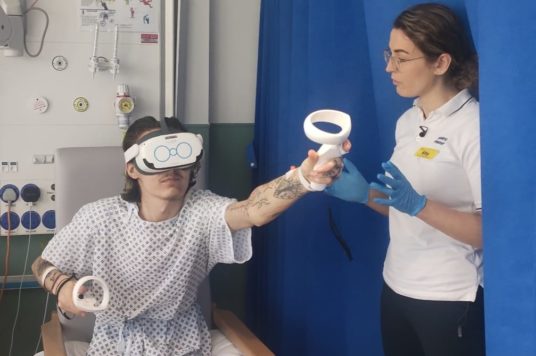One-of-a-kind virtual-reality therapy aids major-trauma patients
Trauma patients with rib fractures, serious leg injuries and amputations are using virtual reality headsets during physio sessions to boost their recovery.
St George’s Hospital – the major trauma centre for South West London and Surrey – has been offering seriously-injured patients the chance to trial the technology as part of their regular therapy.
It includes those who have been assaulted, had a serious fall, or injured in a road accident – like patient Jack Fowler-Thick. The 18-year-old was badly hurt in a motorcycle collision, suffering multiple injuries – and has found the games a vital part of his recovery.
Speaking during a bedside therapy session on the major trauma ward led by trauma physiotherapist Elly Tebbutt, Jack says: “I look forward to this part of the day the best. No one wants to end up in hospital, and this makes me forget that I’m here.”
The headset offers a series of personalised games, such as boxing and archery, and encourages patients like Jack to move through pain – ultimately speeding up recovery.
“It really helps,” adds Jack enthusiastically, as he sits on the edge of his chair during a fruit-picking simulation, watched on closely by Elly. “When I played this yesterday I was in a lot of pain, I found it really hard to move, but I felt much better after using the headset.”
On a neighbouring ward, Becky Perry is several days in to her stay, having been blue-lighted to St George’s and undergoing surgery following a freak accident on her horse. She has an open femur fracture, as well as some rib injuries from a previous incident – and requires intensive therapy.

“It makes me forget that I’m in hospital,” says Becky, as she’s led through a session by trauma physiotherapist Beth Kenny, moving her arms to pick apples from a tree. “Mentally it helps, because I just push through the pain, and I feel like it’s helping my movement and making me stretch more.
“You forget that you’re doing it. The woman in the bed opposite me was laughing so much the other day, I must have looked so silly – but it really does help.
“I definitely think other patients would benefit, I’d recommend it to anyone. The care I’ve received here has been fantastic, I’m so glad I came to St George’s.”
Virtual reality in healthcare is not unusual – but what sets this apart is how the technology is used.
Many hospitals use virtual reality as a way of distracting or entertaining patients – but as far as Elly and Beth are aware, it’s not used anywhere else in a major trauma setting to rehabilitate patients.
“Recovering from a life-changing injury can be painful and scary, and patients often worry their injury could become worse when they start moving around,” says Beth. “But our virtual reality headsets encourage patients like Becky and Jack to move through the pain in a safe way and effective way.”
Elly adds: “We’ve had really positive feedback from the 50 or so people who have trialled the virtual reality headsets. Patients say it helps them to move more easily and manage their pain, in a fun and engaging way.”
Kate Slemeck, Managing Director at St George’s University Hospitals NHS Foundation Trust, says: “Every month our dedicated specialist emergency doctors, nurses, therapists and other staff treat 150 major-trauma patients. We’re very proud of the outstanding care they provide – from lifesaving surgery and psychological support, to these virtual reality sessions, which clearly are a huge benefit to our patients.”


